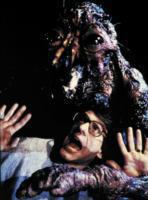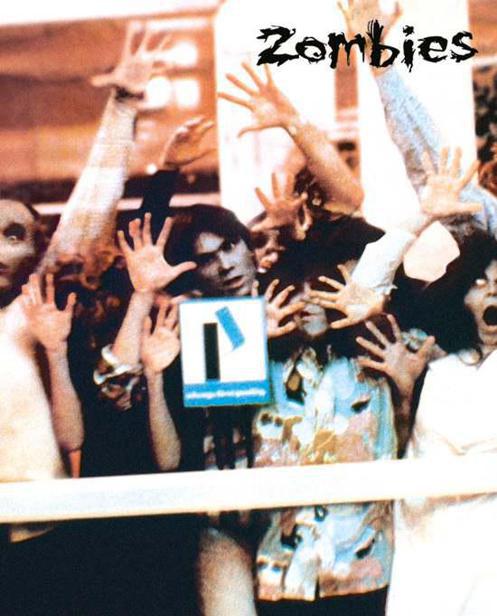
David Cronenberg with the star of The Fly[1986].
JL: Why do we like horror films?
DC: I think it’s a rehearsal for dealing with death…
JL: But that’s what a rollercoaster is. A rollercoaster allows you to feel…
DC: No, no, I don’t agree. You’re talking to someone who has raced cars and motorcycles. Of course there’s an element of “Oh my god I’m going to die,”—a good rollercoaster will give you that. And there’s also the incredible sensation of speed and G forces and there’s a kind of a liberating feeling in that. That’s very exhilarating. It’s not just a death-defying thing. As you know, if you go on a rollercoaster 20 times, you lose the fear.
JL: When you’re racing a Formula One car David, there’s real danger. I mean, you could flip over and die. You can really crash and burn. When you’re on a rollercoaster you have all those sensations of speed and G force and falling, but you know you’re safe. The theory is people go to horror films to experience that stuff, but be safe. But you don’t think so?
DC: I don’t think that seeing a horror film is the same as going on a rollercoaster ride. A rollercoaster ride is visceral and not meditative. A good horror film should have elements of both. A rollercoaster ride is devoid of philosophy, as far as I’m concerned.
JL: Okay, I give up. But why do people want to go see films that will terrify them?
DC: Well, they don’t all. My family dentist once said to me,“Why should I go see your horror films? I have enough horror in my own life!”

Dawn of the Dead[aka Zombi, George A. Romero, 1978] Romero’s vision of the North American consumer; a fairly typical day at the mall.
ZOMBIES
For decades, zombie movies drew on the traditional figures of Haitian Voodoo ritual. The clichéd image of a zombie was a tall, lean black man with glassy eyes. A prime example appears in I Walked With A Zombie[Jacques Tourneur, 1943], which is a much better movie than it sounds. Zombies were called the “Walking Dead” and they tended to shamble along. They may have been slow, but they just kept coming…
The mystical figure of Baron Samedi, Master of the Dead, a spirit (or Loa that can be summoned by a Voodoo priest (or houngan), is always depicted wearing a top hat. Baron Samedi has been portrayed onscreen by Geoffrey Holder in the James Bond film Live and Let Die[Guy Hamilton, 1973] and by Don Pedro Colley in the blaxploitation/horror/gangster picture Sugar Hill[Paul Maslansky, 1974]. A Voodoo priestess is called a mambo (also the name of a popular Latin American dance).
In Haitian Voodoo, a houngan uses poisons and ritual burials to convince victims that they are dead. The houngan then uses their new zombies to pick sugar cane and for other menial tasks. Many claim that this practice continues today. In Voodoo and in the movies, zombies are symbols of exploitation and social decay. Hammer Films’ The Plague of the Zombies[John Gilling, 1966] places witchcraft (Voodoo)-created zombies at the center of a story of typically English class warfare, using the zombies as a menace and as slave labor.
Zombies are basically the Walking Dead. How the dead come to be walking varies. In Stuart Gordon’s wild Re-Animator[1985], a concoction of glowing green liquid injected by syringe does the trick. In An American Werewolf In London[John Landis, 1981], the unfortunate lycanthrope David Kessler (David Naughton) is first visited by his increasingly decayed dead best friend Jack (Griffin Dunne), then surrounded by the gory victims of his “carnivorous lunar activities” who demand he kill himself.Apparently, when the “last remaining werewolf” is destroyed, his victims will cease being “undead.” So are Jack and his companions zombies?
What about those poor unfortunates in all those movies who turn into flesh-eating crazies thanks to medical experimentation, atomic radiation, pollution, or some bizarre virus?
The term zombie has become a bit like pornography—even if we are unable to make a definitive description of exactly what a zombie is, we know a zombie when we see one!
The Spanish zombies in Rec[co-directed by Jaume Balagueró and Paco Plaza, 2007] or the British zombies in Shaun of the Dead[Edgar Wright, 2004], and 28 Days Later[Danny Boyle, 2002] or the French zombies in Paris by Night of the Living Dead[Grégory Morin, 2009] and La Horde[Yannick Dahan, Benjamin Rocher, 2009], the New Zealand zombies in Peter Jackson’s Dead Alive[aka Braindead, 1992], and all those Italian zombies from Michele Soavi’s Dellamorte Dellamore[aka Cemetery Man, 1994] to Lucio Fulci’s Zombi 2[1979] to the Japanese (I swear this is a real movie) Big Tits Zombie[Takao Nakano, 2010] to the all-American Zombie Strippers[Jay Lee, 2008], I think we can safely say that zombies are an international audience favorite.
My personal favorite zombie movie is King of the Zombies[Jean Yarbrough, 1941], a low-budget B movie from Monogram, in which the wonderful Mantan Moreland’s supporting character, Jefferson “Jeff” Jackson, steals the picture as the only one who actually sees the zombies. He is then hypnotized by the villain to believe that he is a zombie, too. Once he thinks he is a zombie, his fear of the authentic zombies is replaced by feelings of camaraderie and good fellowship. Of course, when he discovers that he is not a zombie, he runs in terror from his former “brothers.”
In the 1960s, movie zombies started to eat the flesh of the living, often feasting specifically on brains. In the very funny Return of the Living Dead[Dan O’Bannon, 1985] the zombies even speak! A police car is surrounded by hungry zombies who viciously attack the two cops inside and then gleefully eat their brains. The patrol car’s radio crackles and a voice asks if they need assistance. One of the zombies clumsily takes the microphone and croaks, “Send more cops.”
The Walking Dead is now no longer an all-encompassing term for zombies. In films like Return of the Living Deadand 28 Days Later[Danny Boyle, 2002], the zombies no longer shamble along, they can also run very fast. Assorted causes for their zombification have gone way beyond Voodoo to include atomic radiation, alien invasion, pollution, and weird Ebola-type viruses, sometimes natural, sometimes produced by the military. In Dead Alive, an outbreak of crazed, flesh-eating zombies in New Zealand is started by the bite of a “Sumatran Rat Monkey!”
In contemporary films, zombies are frequently agents of anarchy and represent the collapse of an orderly society. Films like 28 Days Later, Zombieland[Ruben Fleischer, 2009], and both versions of Dawn of the Dead[George A. Romero, 1978 and Zack Snyder, 2004], unleash berserk, flesh-eating zombies and suddenly, it’s every man for himself as hordes of rotting corpses roam the streets and chaos reigns.
Zombies have now evolved into modern agents of the Apocalypse. Based on a video game, the Resident Evilseries of films stars Milla Jovovich as a former employee of an evil corporation who battles zombies through four movies and counting: Resident Evil[Paul W. S. Anderson, 2002], Resident Evil: Apocalypse[Alexander Witt, 2004], Resident Evil: Extinction[Russell Mulcahy, 2007], and Resident Evil: Afterlife 3D[Paul W. S. Anderson, 2010].
Maybe one of the reasons for the increasing popularity of the zombie movie is the aging population of the Western world. As the director David Cronenbergpointed out, “As we grow older, we transform into something monstrous. Our minds begin to fail us, as do our bodies themselves.” Whether or not we like to admit it, we have all felt a horror of the aged and infirm. No one escapes the indignities and terrors of old age, physical decrepitude, and death. One day, the ravages of time will reduce all of us to shambling, drooling, “walking corpses” covered in lesions and clad in loose-fitting hospital robes. As Walt Kelly’s brilliant comic-strip character Pogo discovered, “We have met the enemy, and he is us.”